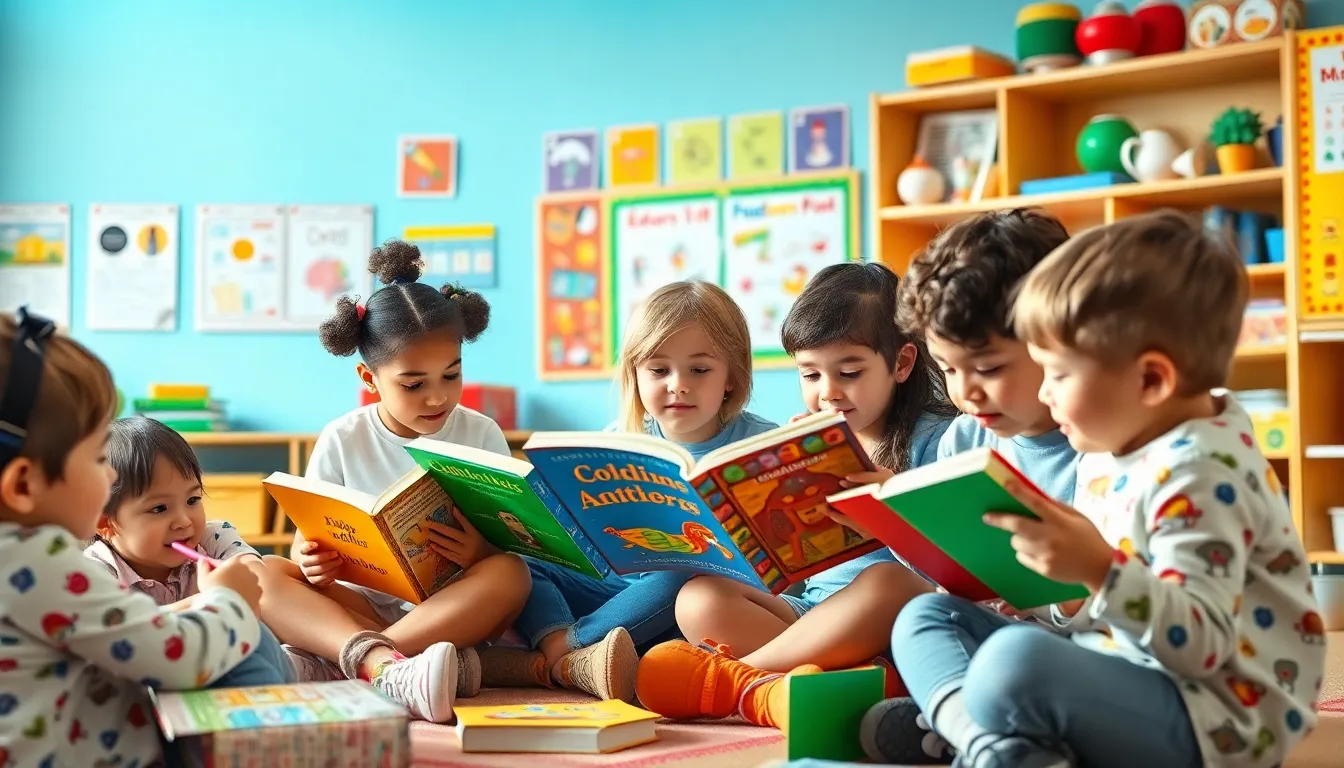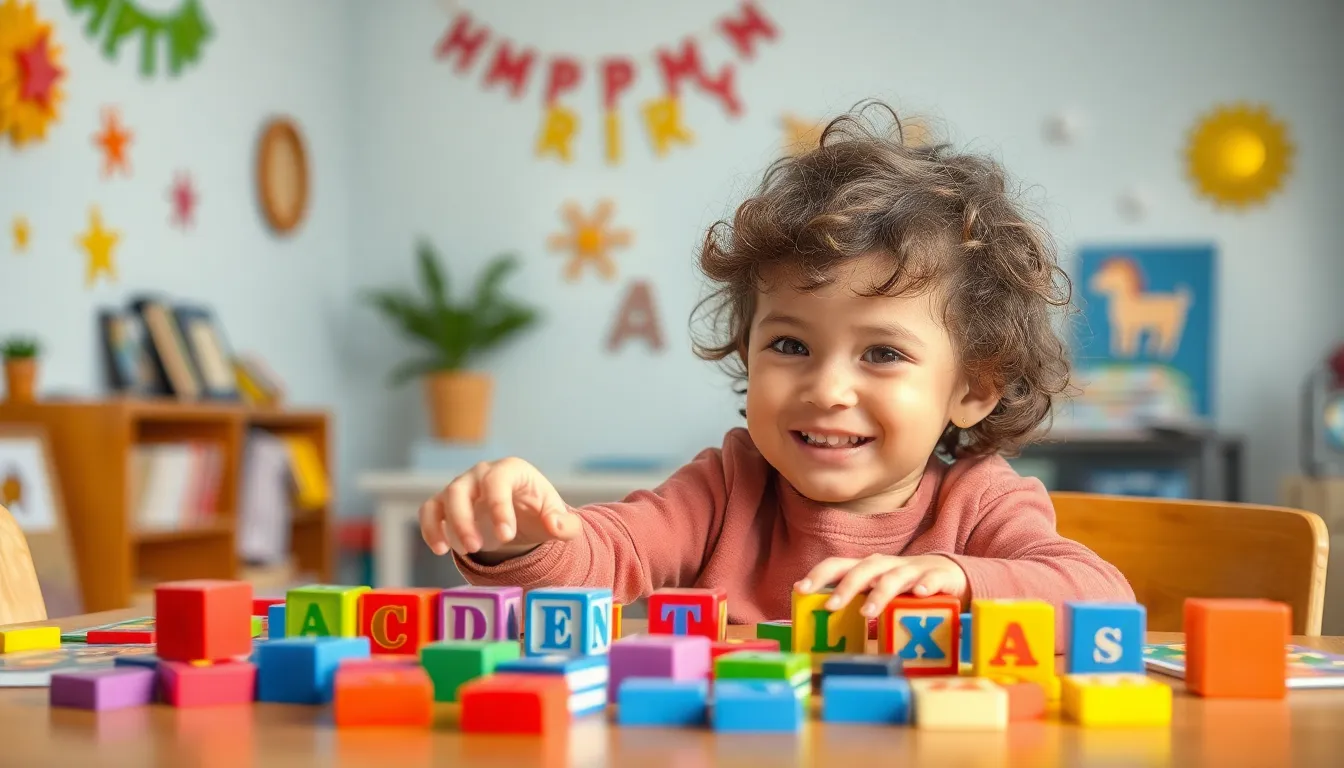Table of Contents
ToggleUnlocking the world of literacy is like embarking on a thrilling adventure, and understanding the stages of literacy development is your trusty map. From the first scribbles of a toddler to the eloquent prose of a high school graduate, each stage is a stepping stone toward becoming a confident reader and writer.
Overview of Stages of Literacy Development
Understanding the stages of literacy development helps in assessing children’s progress. The journey begins with emergent literacy, where children explore print in their environment. Scribbling and experimenting with letters mark this initial stage, laying the groundwork for future reading and writing.
Next is the beginning reading and writing stage. At this point, children start recognizing letters and sounds. They can decode simple words and often illustrate stories. Phonemic awareness plays a crucial role here, facilitating sound-letter connections.
Following this, the transitional literacy stage emerges. Children develop fluency in reading and writing. They read more complex texts and begin writing with a clearer structure. The ability to understand context and use grammar becomes evident during this phase.
The fourth stage, fluent reading and writing, showcases significant skill. Children can read chapter books and comprehend various genres. Writing becomes a means of expression, highlighting individual voice and creativity.
Ultimately, advanced literacy marks the final stage. Young adults engage critically with texts, analyzing and interpreting information. They are equipped for academic and professional demands, often writing essays and research papers.
Each stage builds upon the previous one, underscoring the importance of tailored support for children at varying literacy levels. Recognizing these stages aids in fostering a love for reading and writing.
Importance of Literacy Development

Literacy development plays a critical role in a child’s overall education. Each stage nurtures essential skills that lead to lifelong learning.
Benefits of Early Literacy Skills
Early literacy skills provide numerous advantages. Children gain confidence through experiences with letters, sounds, and print. They learn to communicate effectively, paving the way for better language abilities. Exposure to stories fosters imagination and creativity. Strong foundations lead to enhanced social skills, as children engage in discussions about books. Enhanced vocabulary results from early reading, equipping children with the language necessary for academic success. Ultimately, early literacy sets the stage for a child’s future, supporting both personal and academic growth.
Impacts on Academic Success
Literacy development significantly influences academic performance. Research demonstrates that children with strong reading skills excel in various subjects. They develop critical thinking abilities, essential for analyzing complex information. Furthermore, proficiency in reading and writing facilitates understanding across the curriculum. Teachers identify that students who read regularly are more likely to perform well on standardized tests. Academic engagement increases, as literacy encourages exploration of diverse topics. In short, literacy directly correlates with achievement, making it a vital component of education.
Stages of Literacy Development Chart
The stages of literacy development chart illustrates the progression children undergo as they learn to read and write. Understanding these stages aids in providing appropriate support and fostering a love for literacy.
Pre-Literacy Stage
The pre-literacy stage occurs before formal reading instruction. Children engage with books through shared reading experiences. They experiment with sounds and symbols while developing fine motor skills through activities like scribbling. Interaction with print enhances their familiarity with language. During this stage, caregivers play a vital role by promoting a print-rich environment. Providing access to diverse books sparks curiosity and a desire to explore language further.
Emerging Literacy Stage
The emerging literacy stage marks the beginning of recognizing letters and simple words. Children start to connect sounds with letters, displaying early phonemic awareness. They often attempt to write by illustrating stories and using invented spellings. Exposure to reading plays a critical role in this stage as children begin to recognize familiar words and phrases. Active participation in storytelling activities nurtures their language comprehension. Encouragement from adults boosts confidence, laying the foundation for more advanced literacy skills.
Early Literacy Stage
During the early literacy stage, children advance their decoding skills and become more fluent readers. This development allows them to tackle simple texts with growing confidence. Writing becomes more structured, with clearer sentences and ideas expressed. Vocabulary expansion occurs as exposure to richer text increases. Children begin to understand the mechanics of writing, including punctuation and basic grammar. Engaging in discussions about stories enhances their comprehension and critical thinking abilities.
Transitional Literacy Stage
The transitional literacy stage involves a significant shift toward independent reading and writing. Children gain fluency and can understand more complex texts. They start making connections between the stories they read and personal experiences. Writing reflects individual voice and creativity, showcasing the skills they have developed. Collaborative projects encourage critical engagement with literature. This stage prepares children for greater responsibility in their learning, emphasizing both comprehension and expression.
Independent Literacy Stage
The independent literacy stage signifies the culmination of literacy development. Readers confidently navigate diverse genres and can engage with texts critically. Writing becomes a tool for self-expression and argumentation, demonstrating sophistication in thought. Skills such as summarizing, analyzing, and synthesizing information flourish. Students can tackle academic challenges effectively and engage in discussions with peers. This stage builds the foundation for lifelong learning and intellectual growth.
Strategies for Supporting Literacy Development
Supporting literacy development requires engaging activities and resources tailored to each stage. These strategies promote skills, foster a love for reading, and enhance writing abilities.
Engaging Activities for Each Stage
Emergent literacy involves exploring books and playing with letters through alphabet puzzles and storytime. Beginning readers benefit from interactive read-alouds, allowing them to recognize letters, sounds, and simple words in context. Transitioning to transitional literacy, children enhance their fluency with guided reading sessions, pairing reading with writing activities that encourage expression. Fluent readers can explore book clubs, discussing content and themes to deepen comprehension and critical thinking. Advanced literacy students connect with literature through debates and research projects, fostering analytical skills and independent thought.
Resources for Parents and Educators
Books tailored for specific stages serve as essential tools. For emergent literacy, picture books with repetitive text and rhymes prove effective. For developing readers, chapter books explain new vocabulary while providing engaging narratives. Online platforms like educational websites offer activities and printable resources for beginning and transitional stages. Educators can also utilize local libraries for programs that promote reading and writing. Parents can participate by creating reading routines and using everyday situations to introduce literacy concepts. All these resources contribute significantly to fostering a nurturing learning environment.
Understanding the stages of literacy development is essential for fostering a child’s growth in reading and writing. Each stage builds a foundation for the next, creating a seamless progression that enhances confidence and skills. By recognizing and supporting these stages, caregivers and educators can effectively nurture a love for literacy.
Engaging activities and tailored resources play a crucial role in this journey. As children advance through each stage, they not only improve their academic performance but also develop critical thinking and communication skills. Ultimately, investing in literacy development lays the groundwork for lifelong learning and success.




